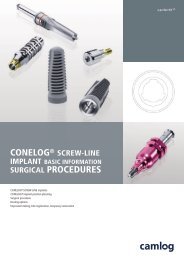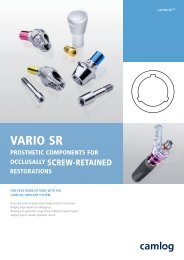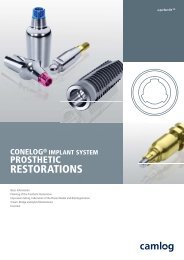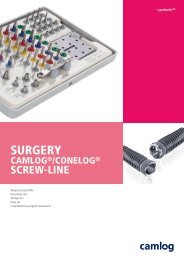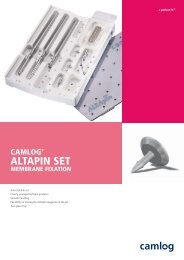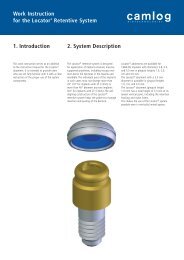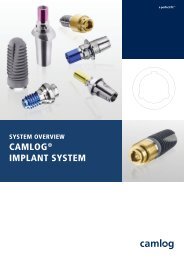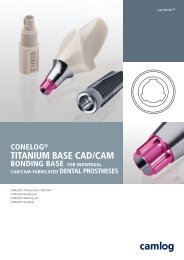Hybrid Restorations with the CAMLOG Implant System (PDF
Hybrid Restorations with the CAMLOG Implant System (PDF
Hybrid Restorations with the CAMLOG Implant System (PDF
Create successful ePaper yourself
Turn your PDF publications into a flip-book with our unique Google optimized e-Paper software.
HYBRID RESTORATIONS WITH THE <strong>CAMLOG</strong> ® IMPLANT SYSTEM<br />
DOUBLE CROWN<br />
RESTORATIONS<br />
For fabrication of double crowns using <strong>the</strong> electroplating technique, <strong>the</strong><br />
manufacturer's specifications must be observed. The preparation for <strong>the</strong><br />
cast fabrication of double crowns occurs similar to <strong>the</strong> cone-telescopic<br />
crown technique. To prevent <strong>the</strong> caps from rotating, <strong>the</strong> abutments are<br />
lightly ground in oval form. The surface must be homogeneous.<br />
The space for <strong>the</strong> tertiary framework required to receive <strong>the</strong> secondary<br />
crowns can be tested at every phase of preparation <strong>with</strong> <strong>the</strong> silicone index<br />
<strong>with</strong> <strong>the</strong> denture teeth in position.<br />
FABRICATING SECONDARY COPINGS<br />
The secondary crowns or superstructure are <strong>the</strong>n fabricated. The tensionfree<br />
seat of <strong>the</strong> superstructure is of paramount importance for <strong>the</strong> longterm<br />
success of an implant-pros<strong>the</strong>tic restoration. We recommend bonding<br />
<strong>the</strong> secondary copings intraorally into <strong>the</strong> tertiary framework (passive fit).<br />
72<br />
NOTES<br />
Electroformed secondary copings<br />
Electroforming is conducted as specified by <strong>the</strong> manufacturer. The<br />
<strong>CAMLOG</strong> ® abutments are inserted into a <strong>CAMLOG</strong> ® lab analog of <strong>the</strong><br />
appropriate diameter and fixed <strong>with</strong> a <strong>CAMLOG</strong> ® lab screw. The thickness<br />
should be 0.2–0.3 mm. The special feature of <strong>the</strong> low layer thickness<br />
of <strong>the</strong> electroformed components and <strong>the</strong> resulting low stability of<br />
<strong>the</strong> secondary coping prevent direct polymerization in <strong>the</strong> acrylic denture<br />
base. For this reason, a tertiary framework must be fabricated over<br />
<strong>the</strong> secondary copings for reinforcement.<br />
Cast secondary copings<br />
The wall thickness of <strong>the</strong> secondary copings should be approx. 0.5 mm.<br />
Fabrication is similar to standard crown and bridge technique.<br />
CAUTION<br />
Do not mix up <strong>the</strong> <strong>CAMLOG</strong> ® abutments and secondary copings! We<br />
recommend a color buccal marker on <strong>the</strong> abutment, coping and working<br />
cast.<br />
For information about "Fabricating a tertiary framework for double crown<br />
restorations", "Bonding of <strong>the</strong> secondary coping intraorally" and "Insertion<br />
of <strong>the</strong> pros<strong>the</strong>tic restoration", see pages 67–68.




